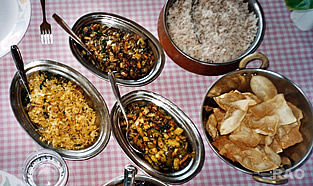|
Bhutan
- Ethnic Groups & People |
 |
Bhutan People Food |
|
 |
Bhutan Information |
|
|
 |
|
Bhutanese
food habit unhealthy
|
 |
 |
| Indian style meal offered to tourists |
| The
food of the Bhutanese is hot and fatty and the dietary habits are also
not very healthy but a little conscious adjustment could bring about positive
changes, according to a food hygienist working with the Public Health
Laboratory in Thimphu for the past year.
According
to food hygienist Tadahiro Sasaki, a JOCV volunteer, Bhutanese consumed
a lot of rice, which is rich in carbohydrates and easily turns into fats
if one did not engage in much physical activity. |
|
"Most
people tend to sleep right after dinner and hence gain weight," said Tadahiro
Sasaki. "You should at least stay awake for about three hours after dinner."
If
getting fat was becoming a problem in urban Bhutan it was because the same
fatty rich traditional diet was being consumed while the lifestyle had
become more sedentary, according to the food hygienist. This was not a
problem in rural Bhutan because the extra calories were burnt working in
the fields.
Bhutanese
in general also ate the same quantity for breakfast, lunch and dinner.
Tadahiro recommends a light dinner since 'sleeping does not burn much energy
as does other activities.'
Majority
of Bhutanese people also did not eat enough vegetables and fruits. Fruits,
especially citrus fruits, were rich in Vitamin C that was very effective
in fighting against cough and cold infection.
Since
vegetables were most of the time cooked and consumed, the little Vitamin
C that is present in the vegetables were also lost.
Suja,
tea and carbonated drinks also figure in Tadahiro's list of unhealthy food.
"Suja has lots of fats and tea and fizzy drinks have a lot of sugar," he
said. "A litre of carbonated drink has about 50 grams of sugar and that
is very high."
Tadahiro
also said that Bhutanese stored their meat in the refrigerator without
covering it hence contaminating other food items in the refrigerator.
"People
also cut vegetables and other food items on the same unwashed cutting board
where the meat is cut and so the microbes get transferred to them," he
said.
During
the past year, Tadahiro also carried out several tests of the Thimphu tap
water and he found them contaminated. He also found that people usually
drank spring water thinking that they were clean and fit for drinking.
"Spring water is not always clean because they are open water sources with
every chance of contamination," he said.
And
then there are the flies that contaminate the food. "Bhutanese are very
religious and so they do not want to kill the flies. The solution is to
keep them away by putting nets on the windows," he said. He also noticed
that most Bhutanese did not wash their hands before eating and after using
the toilet.
But
habit of heating food among the Bhutanese was a healthy practice. "There
are very little cases of food poisoning in Bhutan and that is because food
is always heated before it is eaten. Zaw (roasted rice) and seep (beaten
maize) are good for the jaw since you have to chew them and chewing stimulates
the brain. It's good for young students, they become more clever."

|
| This
article was contributed by Kinley Y Dorji, Kuensel, Bhutan's
national newspaper |
| Traditional Bhutanese Meal |
 |
First we received a big bowl of "red rice", a rice with a natural pinkish grain. I was shown how to use the cooked rice to clean my hands by first rubbing it and then kneading it in my hands. On top of my rice I received a ladle each of "ema datsi" and "shamu datsi." Datsi is a cheese sauce, somewhat close to our idea of a cream sauce, and a Bhutanese favorite. Ema are green chilies. In Bhutan hot peppers are a vegetable, not a spice. Incredible amounts of hot green and red chilies are eaten every day.
The shamu datsi - mushrooms in cheese sauce - were also enriched with lots of chilies. Rounds of arak, a clear alcohol derived from grain, often rice, were also served, but arak turned out to be the wrong kind of drink to fight the spiciness of the food.
Daniel Winkler
| Information on Bhutan |
 |
|



